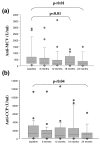Antibodies to mutated citrullinated vimentin for diagnosing rheumatoid arthritis in anti-CCP-negative patients and for monitoring infliximab therapy
- PMID: 19077182
- PMCID: PMC2656247
- DOI: 10.1186/ar2570
Antibodies to mutated citrullinated vimentin for diagnosing rheumatoid arthritis in anti-CCP-negative patients and for monitoring infliximab therapy
Abstract
Introduction: Antibodies against cyclic citrullinated peptides (CCPs) are useful for diagnosing rheumatoid arthritis (RA). Antibodies to mutated citrullinated vimentin (MCV) were described recently in RA. The aims of this study were to evaluate the usefulness of anti-MCV for diagnosing RA in anti-CCP-negative patients and to monitor anti-MCV titres during infliximab therapy for RA.
Methods: We studied two groups of RA patients, one with (n = 80) and one without (n = 76) anti-CCP antibodies. The specificity of anti-MCV was evaluated by investigating 50 healthy controls and 158 patients with other rheumatic diseases (51 psoriatic rheumatism, 58 primary Sjögren syndrome, and 49 ankylosis spondylitis). Serum anti-MCV and anti-CCP titres were measured in 23 patients after 6, 12, 18, and 24 months of infliximab treatment. Anti-CCP2 and anti-MCV levels were assayed using a commercial enzyme-linked immunosorbent assay. IgM rheumatoid factor was determined by nephelometry.
Results: In accordance with the cutoff values recommended by the manufacturer, the specificity of anti-MCV antibodies was 90.9%. We adjusted the cutoff values to obtain the same specificity as that of anti-CCP antibodies (94.2%). With this optimal cutoff, anti-MCV antibodies were found in 11.8% (9/76) of RA patients without anti-CCP, and similarly, anti-CCP antibodies were found in 11.2% (9/80) of RA patients without anti-MCV. Anti-MCV antibodies were positive in 6 patients who tested negative for both anti-CCP and rheumatoid factor. Anti-MCV titres were significantly decreased after 18 and 24 months of infliximab therapy compared with baseline (P < 0.01) as a significant decrease of anti-CCP levels occurred only at 24 months (P < 0.04). Moreover, an anti-MCV decrease was significantly associated with DAS28 (disease activity score using 28 joint counts) improvements 12 months into therapy.
Conclusions: Our results suggest that anti-MCV antibodies may be valuable for diagnosing RA in anti-CCP-negative patients without replacing them as an equivalent number of anti-CCP-positive RA patients test negative for anti-MCV. Moreover, anti-MCV antibodies could be useful for monitoring the effects of infliximab therapy.
Figures

Similar articles
-
Clinical evaluation of anti-mutated citrullinated vimentin by ELISA in rheumatoid arthritis.J Rheumatol. 2007 Aug;34(8):1658-63. Epub 2007 Jul 1. J Rheumatol. 2007. PMID: 17611988
-
Comparison of anti-mutated citrullinated vimentin, anti-cyclic citrullinated peptides, anti-glucose-6-phosphate isomerase and anti-keratin antibodies and rheumatoid factor in the diagnosis of rheumatoid arthritis in Chinese patients.Int J Rheum Dis. 2013 Apr;16(2):157-61. doi: 10.1111/1756-185X.12040. Epub 2013 Feb 5. Int J Rheum Dis. 2013. PMID: 23773638
-
Antibodies against citrullinated vimentin in rheumatoid arthritis: higher sensitivity and extended prognostic value concerning future radiographic progression as compared with antibodies against cyclic citrullinated peptides.Arthritis Rheum. 2008 Jan;58(1):36-45. doi: 10.1002/art.23188. Arthritis Rheum. 2008. PMID: 18163519
-
Diagnostic accuracy of anti-MCV and anti-CCP antibodies in rheumatoid arthritis: A meta-analysis.Z Rheumatol. 2015 Dec;74(10):911-8. doi: 10.1007/s00393-015-1598-x. Z Rheumatol. 2015. PMID: 26111961 Review.
-
Meta-analysis: compared with anti-CCP and rheumatoid factor, could anti-MCV be the next biomarker in the rheumatoid arthritis classification criteria?Clin Chem Lab Med. 2019 Oct 25;57(11):1668-1679. doi: 10.1515/cclm-2019-0167. Clin Chem Lab Med. 2019. PMID: 31141478 Review.
Cited by
-
Serum levels of anti-CCP antibodies, anti-MCV antibodies and RF IgA in the follow-up of patients with rheumatoid arthritis treated with rituximab.Auto Immun Highlights. 2010 Nov 4;1(2):87-94. doi: 10.1007/s13317-010-0013-5. eCollection 2010 Nov. Auto Immun Highlights. 2010. PMID: 26000112 Free PMC article.
-
Anti-MCV antibodies predict radiographic progression in Greek patients with very early (<3 months duration) rheumatoid arthritis.Clin Rheumatol. 2017 Apr;36(4):885-894. doi: 10.1007/s10067-016-3494-4. Epub 2016 Dec 10. Clin Rheumatol. 2017. PMID: 27943044
-
A chronic model of arthritis supported by a strain-specific periarticular lymph node in BALB/c mice.Nat Commun. 2013;4:1644. doi: 10.1038/ncomms2625. Nat Commun. 2013. PMID: 23552059 Free PMC article.
-
Relatives without rheumatoid arthritis show reactivity to anti-citrullinated protein/peptide antibodies that are associated with arthritis-related traits: studies of the etiology of rheumatoid arthritis.Arthritis Rheum. 2013 Aug;65(8):1995-2004. doi: 10.1002/art.38022. Arthritis Rheum. 2013. PMID: 23754702 Free PMC article.
-
Immediate determination of ACPA and rheumatoid factor--a novel point of care test for detection of anti-MCV antibodies and rheumatoid factor using a lateral-flow immunoassay.Arthritis Res Ther. 2010;12(3):R120. doi: 10.1186/ar3057. Epub 2010 Jun 22. Arthritis Res Ther. 2010. PMID: 20569500 Free PMC article.
References
-
- Lawrence RC, Helmick CG, Arnett FC, Deyo RA, Fleson DT, Giannini EH, Heyse SP, Hirsh R, Hochberg MC, Hunder GG, Liang MH, Pilemer SR, Steen VD, Wolfe F. Estimates of the prevalence of arthritis and selected musculoskeletal disorders in the United States. Arthritis Rheum. 1998;41:778–799. doi: 10.1002/1529-0131(199805)41:5<778::AID-ART4>3.0.CO;2-V. - DOI - PubMed
-
- Arnett FC, Edworthy SM, Bloch DA, McShane DJ, Fries JF, Cooper NS, Healey LA, Kaplan SR, Liang MH, Luthra HS, et al. The American Rheumatism Association 1987 revised criteria for the classification of rheumatoid arthritis. Arthritis Rheum. 1988;31:315–324. doi: 10.1002/art.1780310302. - DOI - PubMed
-
- Hoet RM, van Venrooij WJ. The antiperinuclear factor (APF) and antikeratin Abs (AKA) in rheumatoid arthritis. In: Smolen J, Kalden J, editor. Rheumatoid Arthritis. Berlin: Springer-Verlag; 1992. pp. 299–318.
-
- Schellekens GA, Visser H, de Jong BA, Hoogen FH van den, Hazes JM, Breedveld FC, van Venrooij WJ. The diagnostic properties of rheumatoid arthritis antibodies recognizing a cyclic citrullinated peptide. Arthritis Rheum. 2000;43:155–163. doi: 10.1002/1529-0131(200001)43:1<155::AID-ANR20>3.0.CO;2-3. - DOI - PubMed
Publication types
MeSH terms
Substances
LinkOut - more resources
Full Text Sources
Other Literature Sources
Medical

